Rarity Summary by Mint of Mexican Republic ½ Reales
by William Sigl
Series Overview
The ‘Facing Eagle’ variety of Mexican Republic ½ reales was produced from 1825 thru 1869, and was a replacement for the ‘Hookneck Eagle’ variety which had only been produced in 1824. The challenge of collecting ‘Facing Eagle’ ½ reales is undeniable, as there are a large number of hidden rarities and even more grade rarities. Those collectors who focus their attention on the series for a good number of years will ultimately be rewarded with a collection that is worthy of deep admiration.
‘Facing Eagle’ half reales were struck at 11 mints (12 if you count Alamos). Each mint struck half reales for a different subset of dates during this period. Republic ½ reales were made of .903 fine silver, and were supposed to weigh 1.69 grams. Mexican mints at this time were run for a profit, and production of half reales was an unprofitable (but mandated) denomination to produce. Due to this, quality control in the production of half reales was substandard, and as a result the weight of uncirculated half reales tended to vary slightly from coin to coin. It should be noted that the silver content and weight for Iturbide, ‘Hookneck’, and ‘Facing Eagle’ Republic ½ reales were all the same as was the case for earlier portrait Spanish Colonial ½ reales.
Information Vacuum
New collectors of ½ reales are at a tremendous disadvantage because unlike experienced collectors, they rely heavily on the misleading information in current price guides. It is very difficult for new collectors to have courage to effectively compete with advanced collectors for choice ½ reales. Scarce and rare coins are often unrecognized by new collectors. When alerted to a coin‘s true rarity by the seller, most new collectors lack the confidence to pay a fair price because it may be many times what the price guide lists for it.
Advanced collectors of the series have a great advantage over new collectors because in many instances they possess detailed notes from years of observation. When questions arise, the advanced collectors have a good network of fellow collectors whose knowledge can be tapped.
Detailed Rarity By DAM, With Grade Rarity Estimates
Rarity is not currently well recognized. Most collectors assume that coins from certain mints are rarer than others, thus deserving of a higher price. Given the same rarity, a Date/Assayer/Mint (DAM) from Guadalupe y Calvo will sell for more than a DAM from Zacatecas. Variable prices based on rarity are reasonable, but only if data on relative mint rarity is accurate.
There are many varieties, especially in the early DAMs. Some varieties may be rare, even though the normal DAM is common. For the sake of simplicity, the DAM supplement does not address rarity of varieties.
Mint Notes
Where possible, I reveal the following information about the coins produced by each mint:
1) Number of DAMs produced, and the regularity of production
2) Number of common DAMs for the mint
3) Rarity estimation for the mint‘s coins
4) Strike quality by date range
5) Engraving quality
6) Available varieties
7) Availability of high-grade coins
8) Number of assayers.
Knowing relative rarity and various quirks from mint to mint will allow new collectors to more accurately determine which coins to buy, and which may be worth paying a premium for. They will be better armed to compete with other collectors for good pieces that may seem overpriced, but in reality are not.
Alamos
The only date for this mint is 1862. All examples from this date are supposedly contemporary counterfeits, which does not matter much because they are Extremely Rare (XR). I have never seen one, but would still love one in my collection.
Chihuahua
Two DAMs were produced at this mint (1844 and 1845), and both are rare. Prices are far higher than the rarity alone would justify because of demand from mint type collectors (Prices are always higher for coins from mints that produced for very few years).
A type collector looking for a high-grade example from this mint would have to settle for an 1844 in XF. Be prepared to pay $3,000 or more for such an example. In 2007 a few high-grade examples, previously unknown, appeared on the market. It may be another decade before they reappear for sale.
No varieties were produced for either of these two dates. The dies appear to have come from the Guanajuato mint as all have Soho design features. Coincidentally, by 1844 Guanajuato was well on its way to phasing out use of the Soho dies. (Soho dies refer to the design produced in England in 1835 for the Guanajuato mint. In addition to producing the design, it is also widely believed that at the time Guanajuato illegally smuggled hundreds of English made Soho dies into Mexico. )
Great strikes and high quality engraving make high-grade examples beautiful to look at. The trouble is most collectors will never see one available for sale from this mint.
Culiacán
There was intermittent production of ½ reales in Culiacán. Between 1846 and 1869 there were only 15 DAMs produced. Intermittent production is usually an indicator of scarcity among its products, and such is the case here. Four of these dates are common, and coins from this mint can generally be considered Scarce.
It would be easy for a type collector to obtain an example of a Culiacán ½ real in high grade, but most dates are rarely if ever seen in high grade. Chances are good that if you have any Culiacán ½ reales they are dated 1860 or 1861.
Very few of the BU examples are spectacular looking, having subdued luster, and weak strikes. Strike quality is usually low to moderate, caused by weak striking pressure and rust damaged dies. Engraving quality of the dies and punches was generally very good.
Many DAMS have varieties, but few of them command a high premium. Some of the overdates from this mint are among the most obvious overdates possible, with no attempt to hide the old date. This mint never had a major style change. If it were not for the scarcity of coins from Culiacán and the audacious overdates, there are mints that are more fun to collect.
There were two assay initials used during this time by Culiacán (CE and PV), but no dates have more than one assayer.
Durango
There was intermittent production of ½ reales in Durango. Between 1832 and 1869 there were only 28 DAMs produced. None of the Durango ½ reales are common, and coins from this mint can generally be considered Very Scarce.
The strike quality is low in the 1830s and most of the 1840s. The main problems are twofold:
1) the low relief of the Paris dies,
2) low striking pressure.
I suspect that they had acquired dies directly from Paris in 1832, and were never resupplied with more. Running the presses at low pressure was their attempt to preserve the dies. The low strike pressure is probably responsible for the unusually high proportion of low-grade coins from this mint, as their ½ reales wore out prematurely. Engraving quality of the dies and punches was generally very good.
It would be very challenging for a type collector to obtain an example of a Durango ½ real in BU, as only a handful or so BU examples exist. Most dates are rarely seen even in XF. Later date BU examples can have spectacular appearances. I have an 1864 in MS64 that is stunning to look at, but the cost was several thousand dollars.
Most DAMS have numerous varieties. There are so many varieties that few of them command a high premium. Overdating was so common in the 1840s that for some of the dates it is difficult to identify them without pictures of other coins of the same date.
There were five assay initials used in the production of ½ reales by Durango (RL, RM, JMR, CP, and LT). Coins with the RL assay initials were probably struck in Paris, and sent to Mexico as sales samples. Coins with the JMR assay initials sell at a substantial premium. Coins using two different sets of assay initials were struck in only two years.
Estado de México
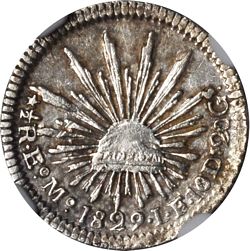
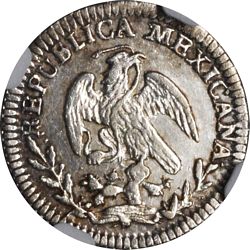
KM-370.4 Estado de México ½ Real, 1829-EoMo LF (Stack’s Bowers auction, 13 February 2019, lot 71390)
This mint produced coins for three years, but ½ reales were only produced in 1829. Due to demand from type collectors, and the coin‘s rarity, ½ reales from Estado de México are extremely expensive. This mint was owned by the state of Mexico, and was mere miles away from the Federal mint in Mexico City. The mint was closed prematurely by the state because it was losing money.
The strike quality is high, but for most people that does not matter because they are generally only available in Good or Very Good condition. AU grade examples exist, but are Very Rare and very highly sought after.
The single DAM has no varieties that I have ever seen.
Guadalajara
Guadalajara was a consistent producer of ½ reales, missing production in only 1827, 1833 and 1836. Between 1825 and 1862 there were 39 DAMs produced. Only four of the Guadalajara DAMs are common, and coins from this mint can generally be considered Scarce to Very Scarce.
The strike quality for Guadalajara is great during the 1820s, 1830s and the first half of the 1840s. Starting in 1848 thru 1862 there were problems with rusty dies. High-grade examples from this period do not have cap or eagle breast details, only raised dots from rust pits.
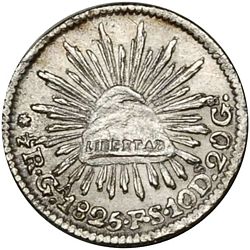
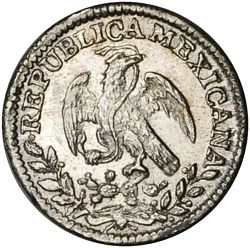
KM 370.5 ½ real Guadalajara 1825 GaFS (Stack’s Bowers Baltimore auction. April 2011. lot 8133)
1825 GaFS is one of the few early dates from this mint that can be found in high grade
It is easy for a type collector to obtain an example of a Guadalajara ½ real in BU, but the date will most likely be 1860 or 1861. The only high-grade DAM possible to get in the 1820s would be 1825. BU examples from the 1820s and 1830s exist, but I have never been offered one for sale. Even XF or AU coins from this period are Rare to Very Rare. It is not until the 1840s where BU examples can be found by the dedicated collector with average connections in the Mexican collecting community. My sincere advice to people wanting to pursue ½ reales collecting is to never pass up purchasing ANY high-grade Guadalajara example unless it is an 1860 or 1861.
Guadalajara varieties are numerous, mostly consisting of overdates and mid-year cap design changes. Unusually, some of the varieties that command the greatest premium are a few of the DAMs that do not have an overdate that year.
There were four assay initials used in the production of ½ reales by Guadalajara (FS, LP, JG and MC). Coins with the LP assay initials were only struck in 1831, and are VERY VERY RARE. Anyone trying to collect one coin from each assayer would probably NEVER get an LP example. Coins were struck four years using two different assay initials.
Guadalupe y Calvo
Guadalupe y Calvo was a consistent producer of ½ reales during its short run from 1844 thru 1851. The collector community is confused about rarity from this mint, thinking that all dates are equally scarce. Despite this, the more available dates from this mint sell at a significant premium from what their actual availability would justify. My experience would lead me to believe that the 1845 and 1847 are the most available. Several of the other dates are far more difficult to acquire than are commonly thought. Coins from this mint can generally be considered Very Scarce. As with most of the other mints, ½ reales do not exist in as great a number as do 1 reales.
The strike quality for Guadalupe y Calvo is less than good. High-grade examples that I have seen exhibit weak cap and eagle breast details, indicating the use of lower pressure on the presses. In 1849 there appeared to be a small problem with rusty dies, but I do not see that in later years. Engraving and sinking of the number and letter punches seems to be a bit cruder than for the main mints.
It would be almost impossible for a type collector to obtain an example of a Guadalupe y Calvo ½ real in BU, but a small number of the dates are available in XF or possibly AU. A few BU examples do exist, appearing at auction every five to ten years.
As far as I know, there are only two varieties (both overdates) from this mint. These are generally worth buying if you ever see one, but at present do not command a premium.
There was only one assay initial used in the production of ½ reales by Guadalupe y Calvo (MP).
Guanajuato
There was uninterrupted production of ½ reales in Guanajuato. The only break in production was during the years of Maximilian‘s reign, when the country produced decimal coinage. Between 1826 and 1868 there were 44 DAMs produced. As a rule of thumb, mints that have uninterrupted production of a series will usually produce coins in vast quantities. Of the Guanajuato ½ reales, 29 DAMs are common. Despite the number of common DAMs, ½ reales are probably only half as numerous as the 1 reales or 2 reales from Guanajuato for the same dates. Coins from this mint can generally be considered Uncommon.
The strike quality from 1826 thru 1843 was good. A surprising number of higher-grade example coins, even though in only XF condition, still have full details on the caps and eagle‘s breast. This is mostly lost on today‘s collectors because very few coins higher than XF still exist, except for just a few dates. Starting in 1844 and 1845 there were problems of low strike pressure and rusty dies. The Guanajuato eagle struck from 1844 to 1853 is especially beautiful if you can ever find an example fully struck. Such examples should command a significant premium, but today do not. Starting again in 1850 thru 1858 strike quality vastly deteriorated due to rusty and eroded dies. BU coins from this period are relatively available, but really well struck coins are scarce. Examples from 1859 thru 1868 are usually well struck.
Engraving quality from 1826 thru 1836 was poor. Once they started using the Soho dies in mid 1835 thru 1844, engraving quality was excellent but that is because most of the dies were made in England. Engraving quality after 1844 was far better than in the early years of the mint. In the last decade of production engraving was on par with Mexico City.
It is pretty easy for a type collector to obtain an example of a Guanajuato ½ real in BU, mainly because of the availability of the 1838, and the later 1850s and 1860s. Many BU coins from 1838 are stunning in appearance if they have not been cleaned, but those from the 1850s and 1860s often do not have an exceptional appearance. There are FAR FEWER BU examples from Guanajuato than there are from Mexico City.
Guanajuato is by far the most exciting of the mints to collect by DAM and variety!!! The number of years with multiple assayers, midyear design changes, and numerous varieties are unmatched in the series. Many of the varieties sell for large or small premiums, but most of the overdates do not. The thrill of the hunt for Guanajuato varieties cannot be overstated!
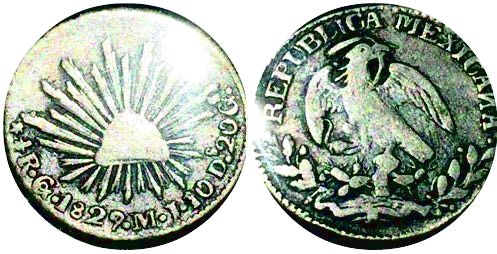 This is one of the most interesting and rare varieties of the series. Note the reversed ‘N’ in ‘MEXICANA’
This is one of the most interesting and rare varieties of the series. Note the reversed ‘N’ in ‘MEXICANA’
The five DAMS that have engraving errors all sell for a very high premium.
1829 reversed ‘N‘ in ‘MEXICANA‘
1831 ‘II‘ in ‘REPUBIICA‘
1832 ‘II‘ in ‘REPUBIICA‘
1834 ‘10Ds 0Gs‘
1839 ‘REPUBLIGA‘
There were an amazing eight assay initial combinations used in the production of ½ reales by Guanajuato (MJ, JG, MR, PJ, PM, PF, YE and YF). Coins were struck in three years using two different assay initial combinations, and in 1828 three different assayer combinations were used.
Hermosillo
There was very sporadic production of ½ reales in Hermosillo, caused by its late authorization to mint silver and the break in production during the years of Maximilian‘s reign, when the country produced decimal coinage. Between 1839 and 1867 there were only three DAMs produced. 1839 is generally considered to be a contemporary counterfeit, but due to its rarity it does not matter much to collectors. If I were offered the coin I would buy it. Half reales from Hermosillo can generally be considered rare. Far more 1 reales from this mint were produced than ½ reales.
The strike quality was good, but does not matter much since only low-grade coins can usually be found. A type collector would stand virtually NO CHANCE of ever acquiring a high-grade example from Hermosillo. Even many of the lowgrade examples are pierced or damaged. If you could ever locate an example in VF, buy it without hesitation. My highest-grade example is in VF, but it has a hole at the top.
Engraving quality of the letter and number punches was very crude. These resulted in several varieties in 1867. Dies with the central design must have come from Culiacán because these features are well engraved.
There were three assay initial combinations used in the production of ½ reales by Hermosillo (PP, FM and PR).
Mexico City
There was nearly uninterrupted production of ½ reales in Mexico City. The only break in production was 1837. Between 1825 and 1863 there were 42 DAMs produced. Of the Mexico City ½ reales, 35 DAMs are common. Overall, coins from this mint can generally be considered Common.
The strike quality from 1826 thru 1838 was excellent. All higher-grade examples exhibit full details on the caps and eagle‘s breast. This is surprising given that the design in this period had a pretty high relief, which points to high striking pressure. Starting in 1839 thru 1844 there were sporadic problems of minor rust on the dies, but the strike pressure continued to be pretty good. Starting in 1845 there was a slight design change where the eagle and cap had a lower relief. From 1845 onward, it is relatively more uncommon to see full details on the cap and eagle. In the future fully struck BU examples from 1845 thru 1863 may command a slight premium. Starting again from 1854 thru 1860 there were sporadic problems with minor rust on the dies.
Engraving quality from Mexico City was Good to Excellent. The only imperfections I have seen are periodic repunched numbers or letters, and punching the letters and numbers in a nonperfect arch.
BU examples of Mexico City ½ reales are more widely available for most DAMs than is the case for coins from any mint for any of the 1, 2, or 4 reales. It is very easy for a type collector to obtain an example of a Mexico City ½ real in BU. There must have been numerous small hoards of ½ reales surfacing over the decades for so many dates to be still available in high grade.
I would highly recommend trying to assemble a collection of each of the Mexico City DAM in high grade (XF to BU). This is the only mint and the only denomination in all of the Republic era where such a collection would be possible for dedicated collectors. Granted that some of the dates are not available in BU, but you could still choose a well struck XF or AU. It took me over ten years to acquire every DAM in high grade from Mexico City in my collection I do not believe it would be significantly more difficult today since many inexperienced collectors try to buy only the highest MS grades possible, rather than having an eye for condition rarities below MS60.
Mexico City has a moderate number of varieties, mainly due to short die life in the 1820s and early 1830s, and periodic mid-year style changes. If you want a challenge, try collecting 1825 and 1826 Mo half reales by die variety. It would be inexpensive and very enjoyable. I tried this and found close to 30 different dies from each date. Since many current collectors consider this a boring mint, most varieties currently sell for little to no premium.
Mexico City takes the record for the mint with the greatest number of different assay initial combinations used in the production of ½ reales. There were 11 different combinations used (JM, MJ, ML, MM, MF, RC, GC, GF, FH, TH and CH). Coins were struck in four years using two different assay initial combinations. In years where multiple assayers produced coins, there is a higher probability that one or more of them will be uncommon to rare.
San Luis Potosí
San Luis Potosí was a consistent producer of ½ reales, after its ten-year halt in production from 1832 thru 1840. From 1831 thru 1863 there were 29 DAMs produced. The number of DAMs from this mint was high mainly because of the number of years with more than one assayer combination. Only two of the San Luis Potosí DAMs are common. Coins from this mint can generally be considered Rare, mainly due to the large number of great rarities from this mint, and the small number of common and uncommon DAMs.
The strike quality for San Luis Potosí coins is very high during the entire production run. If you ever get a BU example from this mint, it will be beautiful with frosty cap and eagle on most examples.
It is possible for a type collector to obtain an example of a San Luis Potosí ½ real in BU mainly because of a hoard of BU coins from the early and mid-1850s that is now widely disbursed among collectors. The only high-grade DAMs possible to get in this series are from this period. BU examples from 1831 exist, but none have ever been offered to me. BU examples from the 1840s may exist, but I have never been offered one for sale. Even XF or AU coins from this period are Rare to Very Rare. It is possible to get high-grade examples from the 1860s but at a much higher price.
There are a moderate number of San Luis Potosí varieties, mostly consisting of overdates, over-assayers, and mint superscripts. Owing to the rarity of the average DAM, varieties usually do not command much of a premium.
There were five assay initial combinations used in the production of ½ reales by San Luis Potosí (JS, PS, AM, MC and RO). In 1842, 1843, 1857, 1858 and 1862 there were two combinations of assayer initials used.
Zacatecas
There was uninterrupted production of ½ reales in Zacatecas. The only break in production was during the years of Maximilian‘s reign, when the country produced decimal coinage. Between 1826 and 1869 there were 43 DAMs produced.
As a rule of thumb, mints that have uninterrupted production of a series will usually produce coins in vast quantities, but here is an anomaly. Half reales from Zacatecas are almost unobtainable compared to its other minor denominations. A possible reason for this scarcity was proposed to me in a conversation with Dave Busse about ten years ago. He said many of the Zacatecas ½ reales were slightly overweight by his measurements, and he accounted for their scarcity due to melting at the time by people who wanted to make a bit of money.
Only five of the Zacatecas ½ reales are common. Overall, coins from this mint can generally be considered Scarce to Very Scarce. At the current time very few people are aware of this and the prices do not adequately reflect their scarcity.
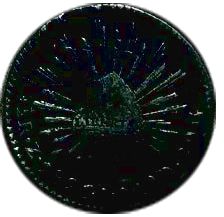
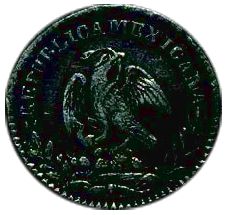
Early dates from Zacatecas in high grade are a rare find. Note the full detail on cap and eagle despite only being in XF condition
The strike quality from Zacatecas was good. There does not seem to be a problem with striking pressure on the vast majority of high-grade examples I have seen. I see no evidence of rusty dies except in 1869. It is likely the case that after 1863, with a five-year period without use, they let the half real dies deteriorate.
Engraving quality was always average or less, especially in the early years thru 1836 when the punches were sometimes pretty crude. There is an interesting feature with the production from 1860 thru 1863, when the assayer was ‘VL’. In every instance that I have seen the ‘V’ is always an upside down ‘A’, showing a reluctance to invest in punches when needed.
It is possible for a type collector to obtain an example of a Zacatecas ½ real in BU, mainly because of the availability of 1860 ZsVL and 1869 ZsYH examples. BU examples of other dates are very difficult to find. You would have to build a lot of relationships among fellow collectors and dealers to stand any chance of obtaining a few examples. There are FAR FEWER BU examples from Zacatecas than there are from any of the other major mints.
Zacatecas produced fewer varieties than many other mints did. Most are overdates, and a few punch varieties. Due to the scarcity of coins from Zacatecas its varieties do not command premiums.
There were seven different assay initial combinations used in the production of ½ reales by Zacatecas (AZ, AO, OV, OM, MO, VL and YH). Coins were struck in four years using two different assay initial combinations.
